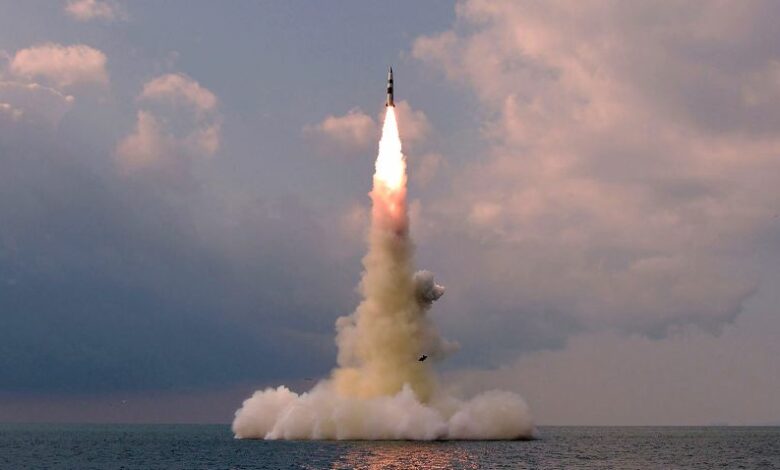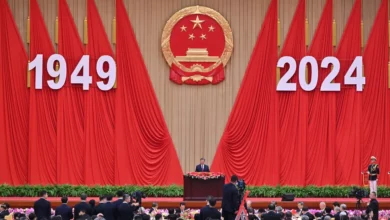
The launch follows several other recent tests of North Korea’s intercontinental ballistic missiles (ICBM), which have raised alarm among adversaries as the isolated authoritarian nation ramps up its efforts to develop weapons capable of potentially striking major US cities.
A White House statement said the launch “risks destabilizing the security situation in the region.”
Japanese Prime Minister Fumio Kishida, speaking from the sidelines of the NATO summit meeting on Wednesday, called the launch “unacceptable’” and a threat to regional stability and the international community.
Wednesday’s test was of the Hwasong-18, a powerful solid-fueled ICBM of a type that Pyongyang last launched in April, according to the state-run Korean Central News Agency (KCNA).
Leader Kim Jong Un said at the time the Hwasong-18 would provide the country with a “powerful strategic attack means” and boost its nuclear capabilities.
Pyongyang tested the liquid-fueled Hwasong-17 in March.
The ICBM fired on Wednesday flew about 1,000 kilometers, staying airborne for 74 minutes, according to Japan’s Defense Ministry – a marginal advancement on the ballistic missiles it tested earlier this year.
Here’s what we know about the ICBMs in North Korea’s arsenal.
Liquid vs. solid-fueled missiles
The Hwasong-17 is a liquid-fueled ICBM unveiled in 2022, when North Korea held its first long-range missile test in more than four years. Liquid-fuel technology is comparatively easier to master.
The Hwasong-18, meanwhile, is a solid-fueled missile, according to Pyongyang – which makes it far more advanced, and would allow North Korea to launch long-range nuclear strikes more quickly.
Solid-fueled ICBMs are more stable, and can be moved more easily to avoid detection before a launch that can be initiated in a matter of minutes, experts say – compared to liquid-fueled missiles that may need hours before launch, giving time for adversaries to detect and neutralize the weapon.
North Korea’s advancement from the Hwasong-17 last year to the Hwasong-18 this year suggests its missile program is making progress, experts say, reflecting Kim’s goal of matching the military capabilities of other nations like the United States or European countries.
Successive launches allow North Korea to gather more data to refine its missile technology.
Can it carry a nuclear warhead?
ICBMs could, at least theoretically, put the entire US mainland in range of a North Korean nuclear warhead – but there’s a lot of unknowns about the missile’s capability to deliver a nuclear payload on target.
Past tests have shown the possible range of North Korea’s missiles – the tests in March and April all traveled about 1,000 kilometers (621 miles). And the Hwasong-17 test last year flew 1,090 kilometers (681 miles), lasting 68 minutes before landing in the sea.
The 74-minute flight time of the latest missile is a few minutes longer than those tested in March and April.
It’s not clear what kind of payloads were involved in these tests. The weight of the payload affects how far a missile can fly, so without this information, observers cannot know for sure the missile’s actual range.
Another question is whether a North Korean nuclear warhead could survive reentry into Earth’s atmosphere.
ICBMs are fired into space, where they speed along outside Earth’s atmosphere before their payloads undergo a fiery reentry process, much like a space shuttle or space capsule, before plunging down on their targets.
If the process of reentering the atmosphere isn’t executed with pinpoint accuracy and with materials that can withstand the immense heat generated, the warhead will burn up before reaching its target. The angle at which the warhead reenters the atmosphere can make the process more difficult.
“The launch of Hwasong-18 shows that it has a range of about 15,000 kilometers based on the altitude, distance and the flight time of the missile,” said Yang Wook, a researcher at Asan Institute for Policy Studies in Seoul.
“However, it cannot be evaluated that North Korea has succeeded in obtaining full technology of an ICBM as it hasn’t proved the functions for reentry and accuracy using multi-warheads that are required for the use of the missile,” Yang said.
What’s next in North Korea’s missile program?
Kim has laid out an ambitious plan to give North Korea a credible nuclear deterrent, meaning an arsenal powerful enough to prevent any adversary, most notably the US, from attacking.
Experts have said the leader has set a long list of weapons modernizations in recent years that he is now working through – with ICBMs only one of those items. Other goals may include launching a military satellite, or putting a nuclear-powered submarine to sea.
Previously, North Korea has announced plans to enhance the accuracy of its missiles and increase the range up to 15,000 kilometers (9,320 miles).
These ambitions were made clear last year when Kim dramatically ramped up the frequency and intensity of weapons testing, which eased slightly this year, but remains at much higher levels than in past years.
The country fired more missiles in 2022 than any other year on record – at one point launching 23 missiles in a single day.
These tests also refocused attention on North Korea’s nuclear goals, with Kim vowing to develop his nuclear forces at the “highest possible” speed last year. The US and international observers began warning last year that an underground nuclear test could be imminent, after satellite imagery showed new activity at North Korea’s nuclear test site. Such a test would be the country’s first since 2017.
Joseph Dempsey, research associate for defense and military analysis at the International Institute for Strategic Studies, said more North Korean tests are likely in the works.
“North Korea’s emergent ICBM force is still relatively untested … further developmental tests to verify their reliability and operation within a range of flight parameters are to be expected,” he told CNN.
How has the US and its allies responded?
The test on Wednesday sparked strong condemnation from neighboring countries.
South Korean President Yoon Suk Yeol, currently at the NATO summit in Lithuania, said he would call for “strong international solidarity” among bloc members in response to the launch. On Wednesday morning, he presided over an emergency National Security Council meeting from Lithuania.
US and South Korean officials met shortly after the test to share information, according to South Korea’s Joint Chiefs of Staff (JCS). Both countries are analyzing the launch.
The Japanese chief cabinet secretary lodged a protest against North Korea through embassy channels in Beijing.
The United Nations Security Council has passed resolutions prohibiting Pyongyang’s ballistic missile testing, but last year China and Russia blocked new resolutions, which the US sees as a green light for North Korea to continue its programs.




